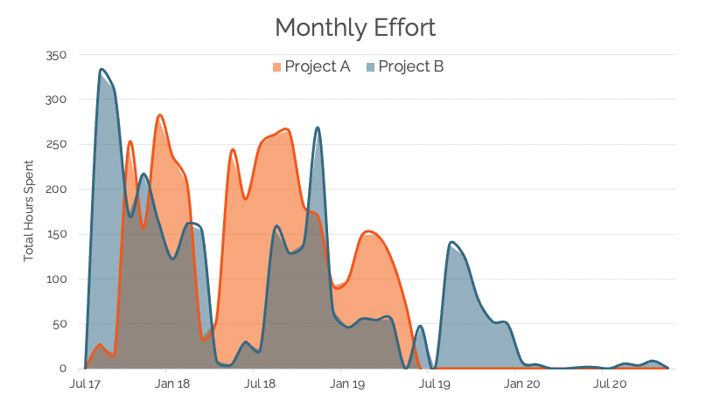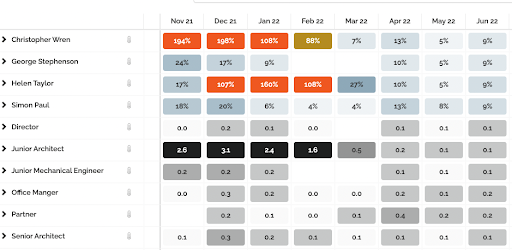The UK construction industry enjoyed a recovery in 2021. And the great news is, this positive trajectory is expected to continue through 2022 and beyond:
“With Government investment in transport and renewable energy driving the recovery and residential continuing to strengthen, analysts are expecting this positive outlook to continue through to 2025.” BusinessWire
With the plethora of new projects up for grabs, it also means many architectural practices are contemplating increasing their workforce.
However, hiring too quickly could backfire!
Getting the right resource vs workload balance is a tricky business. Too few staff and we can't deliver, too many and profitability suffers.
There are 3 main factors to consider when getting your workload-resource balance right:
- Construction is cyclical - and even worse for architects!
- Individual project workloads vary over time
- Hiring and lay-offs are multi-month processes
1 Construction is cyclical
We all know the construction industry has regular peaks and troughs. However, the effects of these cycles are dramatically amplified for architects.

source:The Fees Bureau Architects Fees
The graph above shows how the construction industry (white line) cycles are amplified compared to GDP (grey line). This is because when times are good in the general economy, many construction projects get approved - and conversely when general economic indicators are not great, many construction projects get put on hold.
The architects’ workload boom/bust cycle is even more exaggerated. Why? Because in boom times the macro economic indicators that all developers are tracking suddenly make many projects feasible - which leads to architects getting asked to do loads of pre-planning and concept design work (often on projects that never progress to construction stage). And in bust times (when the indicators mean few projects are feasible), this type of work dries up entirely.
While we might find ourselves currently at the start of a boom stage (and will need additional resources to deliver our workloads), be assured that the wheel will turn at some point - and we need to be careful we aren't over-resourced at that point.
2. Individual Project Workloads Vary
Construction projects can take months and years to complete. Which means our planning window is very long and susceptible to many project specific changes.
As an example, the below graph represents the total hours spent per month across two projects. Both projects are similar in scope and value, and were executed by the same architectural practice. From their Fresh Projects data (the practice uses Fresh Projects), you can see how vastly different the project hours/ effort shapes are. Projects that on paper should be nearly identical, play out very differently in execution.

To complicate matters, the type of resource needed at different stages of a project will vary. At the beginning of a project your senior staff are highly involved with winning the project, conceptualisation and planning. And as the project goes on typically your more junior staff handle the bulk of the on site delivery.
Different projects will have different demands on different resources at different times - which makes balancing workloads across your practice even more difficult. Yet it becomes even more critical to get it right to avoid burnout and/or bankruptcy.
3. Hiring (and redundancies) is a multi-month process
Hiring staff, and in particular high quality staff, is not an instant process. Realistically you’re looking at a 2 to 3 months delay between when you realise you need more staff to your new recruits starting. Similarly when laying off staff there is a well-defined process that needs to be followed before your financial commitments are fulfilled.
The effect of this time lag is the third important factor to consider when juggling resources in your practice. We often see, particularly in the larger practices, that this delay leads to a similar amplification of the construction cycles: i.e. too many staff get made redundant, and by the time the redundancies are completed, workloads pick up and everyone is over-worked and stressed out resulting in a surge in new hires - often more than what is really needed in the long term - resulting in too many staff and not enough work, and so the cycle repeats.
Doomed?
We operate in a sector that suffers from wild economic swings. We deliver multi-year projects, of which no two are alike. And any resourcing decisions we make take months to take effect.
The good news is that there are steps you can take to avoid a complete breakdown. Taking a measured, well thought out and informed long term view of your project requirements and income can help you smooth out the boom/bust cycles - along with all the associated stress.
How to get the balance right?
Here are 4 Fresh Projects features that can help you get the balance right, effortlessly.
1. Simple Scheduling: The high level (month to month) project effort planner enables you to schedule RIBA project stages (along with all associated resources) with a few clicks.

2. Consolidated Workloads: One simple view of your overall monthly resource workloads. This quickly identifies staff members who are over allocated and others who could pick up the extra workload. It even allows you to identify potential new hires that may be needed in the future.

3. Cash Flow Management: Auto match invoicing to your projected project costs with 1-click. At a project level this ensures you are getting paid for for work as soon as it is done.

4. Weighted- income forecast: But even better, when you aggregate the shaped fee forecasts across all your projects, you can identify when your salary bill is unlikely to be met, or when you can afford a new hire.

Want to learn more about how Fresh Projects can help you smooth out the resource requirements in your firm ? Book a demo now!
